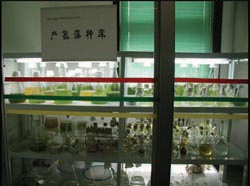
Hydrogen is often hailed as a potential source of unlimited clean power. It can be produced with green algae from water and solar energy through a process called "photobiological hydrogen production." Although its efficiency is rather low at present, scientists believe, an increase to 10% would make this process economically feasible.
Significant progress has been achieved by Prof Zhang Wei and his group at the CAS Dalian Institute of Chemical Physics (DICP) since they took the lead to challenge the problem in China in 2000 with initial support from CAS. Their work has been further funded by the National Basic Science Program (or 973 Program) in 2004.
With sea water as the substrate and solar light the energy source, the goal of the project is to develop a marine green algae-based, cost-effective system for sustained hydrogen photoproduction system.
"Our emphasis is placed on the metabolic regulation of hydrogen metabolism and engineering analysis of the hydrogen production system," said Prof. Zhang, who rejoined DICP through the prestigious CAS
Bairen Program in 2000 after spending nearly five years abroad.
We focus on marine green algae rather than freshwater ones exclusively used internationally in USA, Europe and Japan, Zhang added. "We believe that the utilization of seawater is more meaningful for a sustainable production of hydrogen."
So far, important results have been achieved by the DICP group. They initiated China's first National Collection of Hydrogen-Producing Microalgae, which now has over 20 strains. In addition, they set up two screening system for hydrogen-producing green algae. The first one is a system under the sulfur deprivation condition, which has been proven in US as the controlling factor of triggering hydrogen metabolism. The second was to screen the hydrogen-producing algae with the addition of a proton uncoupler carbonyl cyanide m-chlorophenylhrazone (CCCP), which can accelerate hydrogen production significantly.
By far, the scientists have obtained six hydrogen-producing strains, including a marine green alga, Platymonas subcordiformis, which could produce 0.2% hydrogen within five hours in a 250 ml culture system in natural seawater.
The photo-biological hydrogen production is a two-stage process. The first stage is algae cell culture in the light and the second is hydrogen production after a period of dark anaerobic incubation. To improve the light conversion efficiency, the group, designed and constructed, for the first stage, a 5-L airlift photobioreactor and 50-L Biocoil Photobioreactor system for high-density culture of hydrogen-producing microalgae. In manipulating hydrogen metabolism in the second stage, they have found that a proton uncoupler, CCCP significantly stimulates hydrogen production in Platymonas subcordiformis, however sulfur deprivation shows small increase in hydrogen production.
Based on this finding, the researchers have invented a method to metabolically regulate hydrogen metabolism in a marine green alga Platymonas subcordiformis, resulting in an increases of more than 300 fold yield of hydrogen. Although the hydrogen productivity at 1.9 ml/h.l is slightly higher when compared with the best system invented by UC-Berkeley and the US Department of Energy, hydrogen production time in Dalian system is about 12 hours, much less than the 100 hours of UC-Berkeley Process.





